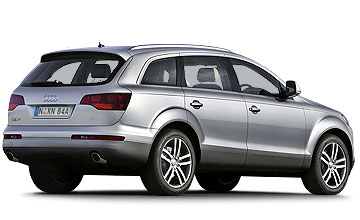BY CHRIS HARRIS | 15th Sep 2006

THERE is no escaping the size of Audi’s Q7 SUV.
Even in the Outback, with few cars and even fewer SUVs except Toyota LandCruisers, the Q7 is a big beast.
At 5086mm long, 1983mm wide, 1737mm high and sitting on a 3002mm wheelbase, it dwarfs some of its competitors.
By comparison the mother of all off-roaders, the LandCruiser, is 4890mm long, 1940mm wide and 1890 high and sits on a 2850mm wheelbase.
As a concession to its size, Audi has wisely included front and rear parking sensors, as well as a rear-view camera as standard. They are ideal additions for the city, where Audi’s latest off-roader will spend most of its time.
But before you think the Q7 is just another lumbering, poorly executed SUV take a look and take it for a drive.
The styling is complete, and resolved in a manner that makes it look more like a pumped-up wagon rather than an SUV on steroids.
It suffers none of the styling bulk of the BMW X5, nor the elongated van-like flabbiness of the Mercedes-Benz R-class.
Audi’s designers have used some neat tricks to lessen the car’s visual bulk, like the way the roof line slopes rearward, the angled rear-most window and the contrasting plastic lower door panels, which get thicker in profile as it runs along to the car’s rear, giving the car a more athletic profile.
From the front the Audi corporate grille sits out and proud but also manages to blend the bonnet line into a seamless grille and bumper. An issue for some buyers may be the lack of a “real” bumper but Audi assured us the massive grille can handle an 8km/h impact without damage.
At the rear, the hatch design incorporates the tail-lights giving the Q7 a wide and uninterrupted hatch that offers easy access to the rear.
Access to the interior is also good but adults may find the optional third-row a bit of a struggle. A virtue of its long wheelbase is that all occupants have good legroom while headroom is also generous.
Audi claims the Q7 offers 28 different seating and load configurations and we’ll have to take there word for it as the 3.0-litre TDI we drove was loaded to the gunnels with spare tyres, small refrigerated esky, camping equipment and fold up chairs, giving the car an on-road weight of more than 2.6 tonnes.
Still, the superb 3.0-litre TDI - with 171kW at 4000rpm and 500Nm from 1750rpm - performed faultlessly through some demanding Outback driving from Broken Hill to Birdsville, a distance of more than 1100km over roads you could manage in your Holden but the added ground clearance of the Q7 made driving a breeze.
According to the trip computer the TDI managed 9.7L/100km at an average speed of 104km/h across one particularly smooth section of road, which makes Audi’s official figure of 8.3L/100km entirely achievable.
So accomplished was the Q7 over the varying Outback terrain that it felt like a much smaller vehicle.
The steering turns-in crisply, the ride – even in the non-air-suspended TDI – was composed and smooth over some particularly rough gravel roads, proving that Audi’s newest off-roader can be just as much fun in the Outback as it will be at home in the city.
Audi admits that most owners will never venture off the black-top, but it’s reassuring to know that if you do venture Outback, the Q7 will make it back.
Even the famous "Big Red" sand-dune near Birdsville failed to stop the car and the Q7 does not have a low-range gearbox.
There are times when you’re aware of the car’s bulk, like lane-changing or particularly sharp corners, where the Q7 will lean, ever-so-slightly, but it will retain its composure. In extreme cases where the car’s physical size takes over, the ESP system gently sets you back on the right path.
Until the new X5 arrives, the Q7 makes a strong case to challenge the BMW’s benchmark ride and handling.
The Q7 has excellent on-road steering and ride. The same can be said about its off-road behavior.
The base 3.0-litre TDI is well specified.
It comes with eight airbags, 18-inch alloys, full-size spare, reach and height adjustable steering, ESP, quattro all-wheel drive, aluminum roof rails, front and rear parking assist with rear camera, four 12-volt outlets, heated exterior mirrors, front and rear foglights, full-size spare wheel, remote central locking, cruise control, 11-speaker stereo with CD changer, trip computer, auto dimming interior mirror, aluminum dash highlights, Cricket leather upholstery, multi-media interface control with colour monitor, multi-function steering wheel and luggage cover and net.
All versions come with six-speed tiptronic transmissions and quattro four-wheel drive with a 40/60 torque split between front and rear axles. This provides a sportier, slightly rear-biased characteristic when barreling down gravel roads.
An "off-road ESP" setting also lifts the threshold for some enjoyable but restrained driving.
In extreme conditions up to 65 per cent of drive can be directed to the front wheels, or up to 85 per cent to the rear.
Although the Q7 is a true outback tourer, most of them will spend its time tooling around the more affluent suburbs, ferrying children to and from school and sports events with the occasional jaunt to the snowfields.
The population might well be diminishing, but today’s children seem to have more friends, in which case they’ll appreciate the Q7 as much as their parents will.